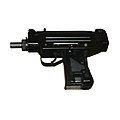
Uzi
The Uzi ( /ˈuːzi/ ; Hebrew: עוזי, romanized: Ūzi; officially cased as UZI) is a family of Israeli open-bolt, blowback-operated submachine guns and machine pistols first designed by Major Uziel "Uzi" Gal in the late 1940s, shortly after the establishment of the State of Israel. It is one of the first weapons to incorporate a telescoping bolt design, which allows the magazine to be housed in the pistol grip for a shorter weapon.
For other uses, see Uzi (disambiguation).Uzi
Submachine gun
Machine pistol (Mini Uzi, Micro Uzi, Uzi Pro)
Semi-automatic pistol (Uzi pistol, Uzi Pro pistol)
1954–present
See Users
- 1950s
- 1960s
- 1970s
- 1980s
- 1990s
1950[13]
Israel Military Industries
Israel Weapon Industries
Copies or variants made by:
- FN Herstal
- Norinco
- Z111 Factory
- Lyttleton Engineering Works (under Vektor Arms)
- RH-ALAN
- Group Industries
1950–present
10,000,000+[14]
See Variants
3.5 kg (7.72 lb)[12]
- 445 mm (17.5 in) stockless
- 470 mm (18.5 in) folding stock collapsed
- 640 mm (25 in) folding stock extended[12]
260 mm (10.2 in)[12]
600 rounds/min
950 rounds/min Mini Uzi
1200–1500 rounds/min Micro Uzi[12]
200 m[16]
- 10-round box magazine (.22 and .41 AE)
- 12-, 16-, or 22-round box (.45 ACP)
- 20-, 25-, 32-, 40-, or 50-round box (9×19mm Parabellum)
The Uzi prototype was finished in 1950. It was first introduced to Israel Defense Forces (IDF) special forces in 1954, and the weapon was placed into general issue two years later. The IDF supplied Uzis to rear-echelon troops, officers, artillery troops and tank crews, as well as a frontline weapon by elite light infantry assault forces.
The Uzi has been exported to over 90 countries.[14] Over its service lifetime, it has been manufactured by Israel Military Industries, FN Herstal, and other manufacturers. From the 1960s through to the 1980s, more Uzi submachine guns were sold to more military, law enforcement and security markets than any other submachine gun ever made.[17]
Total sales of the weapon to date (end of 2001) has netted IMI over 2 billion US dollars, with over 90 countries using the weapons either for their armed forces or in law enforcement.[17]
Civilian variants[edit]
Uzi carbine[edit]
The Uzi carbine is similar in appearance to the Uzi submachine gun. The Uzi carbine is fitted with a 400-millimetre (16 in) barrel, to meet the minimum rifle barrel length requirement for civilian sales in the United States. A small number of Uzi carbines were produced with the standard length barrel for special markets. It fires from a closed-bolt position in semi-automatic mode only and uses a floating firing pin as opposed to a fixed firing pin.[27] The FS-style selector switch has two positions (the automatic setting was blocked): "F" for "fire" (semi-auto) and "S" for "safe". Uzi carbines are available in .22 LR, 9mm, .41 AE, and .45 ACP calibers.
The Uzi carbine has two main variants, the Model A (imported from 1980 to 1983) and the Model B (imported from 1983 until 1989). The Type A was the same as the fully automatic Uzi, while the Type B had a firing pin safety and improved sights and sling swivels. These two variants were imported and distributed by Action Arms.[27]
The American firm Group Industries made limited numbers of a copy of the Uzi "B" model semiauto carbine for sale in the US along with copies of the Uzi submachine gun for the U.S. collectors' market. After registering several hundred submachine guns transferable to the general public through a special government regulated process, production was halted due to financial troubles at the company. Company assets (including partially made Uzi submachine guns, parts, and tooling) were purchased by an investment group later to become known as Vector Arms. Vector Arms built and marketed numerous versions of the Uzi carbine and the Mini Uzi.[35]
Today, while the civilian manufacture, sale and possession of post-1986 select-fire Uzi and its variants is prohibited in the United States, it is still legal to sell templates, tooling and manuals to complete such conversion. These items are typically marketed as being "post-sample" materials for use by federal firearm licensees for manufacturing/distributing select-fire variants of the Uzi to law enforcement, military and overseas customers.[36]
Mini Uzi carbine[edit]
The Mini Uzi carbine is similar in appearance to the Mini Uzi machine pistol. The Mini Uzi carbine is fitted with a 500-millimetre (20 in) barrel, to meet the minimum rifle overall length requirement for civilian sales in the United States. It fires from a closed-bolt position in semi-automatic mode only.[27]




